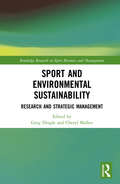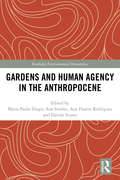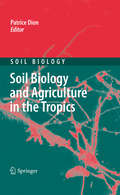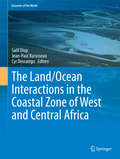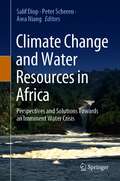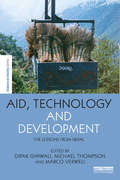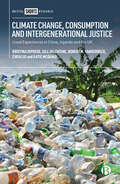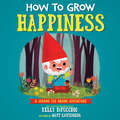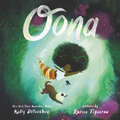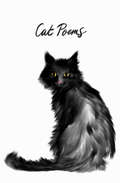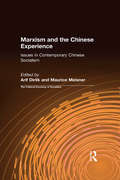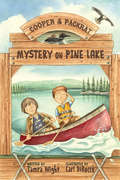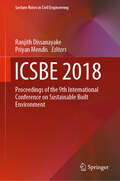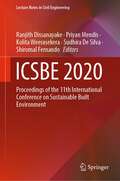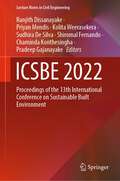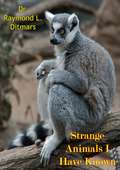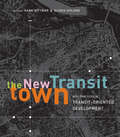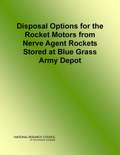- Table View
- List View
Sport and Environmental Sustainability: Research and Strategic Management (Routledge Research in Sport Business and Management)
by Greg Dingle Cheryl MallenDrawing on recent work in sport studies, business and management, health, science, and law, this book offers a critical examination of the latest published research on sport and environmental sustainability. It examines how strategic management, policy and education influence the relationship between sport and the natural environment, and how the transmission and advancement of knowledge via research journals can, and should, have an impact on policy and practice. Covering sport at all levels, from professional to non-profit, and across all sectors of sport management, from marketing and events to facilities and communications, Sport and Environmental Sustainability makes a powerful argument for an awareness of, and need for, environmental sustainability in sport. Chapters outline the research and methods used, expose gaps in the literature and encourage opportunities for future inter-disciplinary research. Topics include sport and climate change, sport and safeguarding air and water quality, education for sustainability, and sport policy. This is an invaluable resource for researchers in sport and environmental sustainability, and academics working in sport management, business, recreation and leisure studies, and sustainability programs, as well as sport policymakers and industry practitioners.
Opossum (Nature's Children)
by Laima DingwallHow is the opossum related to the Tasmanian Devil? Is an opossum bigger or smaller than a house cat? What happens when an opossum "plays dead"? Find the answers to these questions, and learn much more about the physical characteristics, behavior, habitat, and lives of opossums.
Porcupines (Nature's Children)
by Laima DingwallWhen do porcupines sing? What's a porcupette? Why do porcupines eat sneakers and steering wheels? Find the answers to these questions, and learn much more about the physical characteristics, behavior, habitat, and lives of porcupines. Other books in this series are available in this library.
River Otter (Nature's Children)
by Laima DingwallDid you know... that river otters are considered the clowns of the animal kingdom; that otters do not hibernate but will play, swim and live out their winters under the ice; and that otters use tools to eat their food. Find out lots of exciting facts about this wonderful creature.
Skunks (Nature's Children)
by Laima DingwallWhat makes skunks so smelly? How many species of skunk are there? Where do Skunks live? You will learn the answers to these and other questions you have about these stripped members of the weasel family.
Woodchucks (Nature's Children)
by Laima DingwallWhich North American animal has a holiday named after him? Do woodchucks really sleep through the winter? What do groundhogs eat? Read all about the physical characteristics, habits, and natural environment of woodchucks.
Gardens and Human Agency in the Anthropocene (Routledge Environmental Humanities)
by Maria Paula Diogo Ana Duarte Rodrigues Ana Simões Davide ScarsoThis volume discusses gardens as designed landscapes of mediation between nature and culture, embodying different levels of human control over wilderness, defining specific rules for this confrontation and staging different forms of human dominance. The contributing authors focus on ways of rethinking the garden and its role in contemporary society, using it as a crossover platform between nature, science and technology. Drawing upon their diverse fields of research, including History of Science and Technology, Environmental Studies, Gardens and Landscape Studies, Urban Studies, and Visual and Artistic Studies, the authors unveil various entanglements woven in the past between nature and culture, and probe the potential of alternative epistemologies to escape the predicament of fatalistic dystopias that often revolve around the Anthropocene debate. This book will be of great interest to those studying environmental and landscape history, the history of science and technology, historical geography, and the environmental humanities.
Soil Biology and Agriculture in the Tropics
by Patrice DionThe relationships between soils, microbes and humans are of crucial relevance in the tropics, where plant stress and microbial activity are exacerbated. This volume of Soil Biology presents the living component of tropical soils, showing how it is shaped by environmental conditions and emphasizing its dramatic impact on human survival and well-being. Following an introduction to the specificities of tropical soils and of their microbial communities, the biological aspects of soil management are examined, dealing with land use change, conservation and slash-and-burn agriculture, the restoration of hot deserts, agroforestry and paddy rice cultivation. As they are of particular relevance for tropical agriculture, symbioses of plants and microbes are thoroughly covered, as are the biodegradation of pesticides and health risks associated with wastewater irrigation. Lastly, traditional soil knowledge is discussed as a key to our sustainable presence in this world.
The Land/Ocean Interactions in the Coastal Zone of West and Central Africa
by Salif Diop Jean-Paul Barusseau Cyr DescampsAlthough the main focus of this book is on the estuaries, its scope goes well beyond this particular coastal feature. Indeed, the estuary can only be considered as part of the life cycle of the entire river and the marine area it feeds into: an area particularly subject to human and natural pressures. The main estuaries and deltas of West and Central Africa region provide a variety of goods and services to its coastal population. The most important of them are related to critical fish habitat, wood and charcoal from mangroves, as well as space for agriculture, aquaculture, urban development, tourism and transport. Particular emphasis has been made in this book on mangroves that play a significant role in terms of flood control, groundwater replenishment, coastline stabilization and protection against storms. They also retain sediments and nutrients, purify water, and provide critical carbon storage. Such hydrological and ecological functions explain the focus on serving mangrove ecosystems and the nearby communities, which draw significant income from fishing, rice production, tourism, salt extraction and other activities such as harvesting honey and medicinal plants, hence the need for preserving mangrove ecosystems to ensure sustainability of the estuaries and deltas of West and Central Africa region. The book has a foreword by Mr. Achim Steiner, United Nations Under-Secretary General and Executive Director of UNEP who is stating that credible and up-to-date information is essential for the public at large but more specifically for scientists, researchers, managers, decision-makers all working together in order to safeguard, protect and sustainably manage estuaries, deltas and lagoons, and the coastal and ocean waters of Western and Central Africa.
Climate Change and Water Resources in Africa: Perspectives and Solutions Towards an Imminent Water Crisis
by Salif Diop Peter Scheren Awa NiangThe focus of this book is on the key water-related vulnerabilities to climate change in Africa, particularly in its most vulnerable areas, exploring potential management responses to such vulnerabilities. The African countries are particularly exposed and vulnerable to the negative impacts of climate change, with important impacts on water resources and hydrological systems, water availability, water resource management and sea level variations. Already, under various anthropogenic pressures, the status of water resources in Africa has been changing over the past decades, with decreasing water quality, falling groundwater levels, and variability in rainfall, both in terms of timing and intensity. Climate change will further accelerate the rate of change, affecting the ability of people and societies to respond in a timely manner. It is clear that there is no quick fix to the pressures imposed on water resources by climate change. Increasing the resilience of ecosystems and communities to extreme events such as flooding and drought, and integrating climate change risks and opportunities into development decision-making is indeed a key challenge, as much a technical climate-change one, as a political and developmental challenge. The book, in this regard, intends to contribute to the debate around climate change in relation to water resources management in Africa, and in particular inform policy decisions and actions that will improve governments’ and communities’ ability to manage the challenges of climate change and variability in relation to the aquatic ecosystems that they depend on. The knowledge collected in this book will benefit policy makers, researchers, as well as other stakeholders.
Aid, Technology and Development: The Lessons from Nepal (The Earthscan Science in Society Series)
by Dipak Gyawali, Michael Thompson and Marco VerweijOver the last 50 years, Nepal has been considered an experiential model in determining the effectiveness and success of global human development strategies, both in theory and in practice. As such, it provides a rich array of in-depth case studies in both development success and failure. This edited collection examines these in order to propose a novel perspective on how human development occurs and how it can be aided and sustained. Aid, Technology and Development: The lessons from Nepal champions plural rationality from both a theoretical and practical perspective in order to challenge and critique the status quo in human development understanding, while simultaneously presenting a concrete framework with which to aid citizen and governmental organisations in the galvanization of human development. Including contributions by leading international social scientists and development practitioners throughout Nepal, this book will be of great interest to students, scholars and practitioners working in the field of foreign aid and development studies.
Climate Change, Consumption and Intergenerational Justice: Lived Experiences in China, Uganda and the UK
by Kristina Diprose Gill ValentineThe United Nations 2030 Agenda for Sustainable Development makes climate change and responsible consumption key priorities for both industrialized and emerging economies. Moving beyond the Global North, this book uses innovative cross-national and cross-generational research with urban residents in China and Uganda, as well as the UK, to illuminate international debates about building sustainable societies and to examine how different cultures think about past, present and future responsibility for climate change. <p><p> The authors explore to what extent different nations see climate change as a domestic issue, whilst looking at local explanatory and blame narratives to consider profound questions of justice between those nations that are more and less responsible for, and vulnerable to, climate change.
How to Grow Happiness
by Kelly DiPucchioJerome the Gnome takes young readers on whimsical adventures through his garden, celebrating discovery and sowing the imagination as he introduces topics such as science, environmental awareness, and agriculture.In How to Grow Happiness, Jerome and his fellow Garden of Wonder dwellers—including Oakie, his pet acorn; Nutilda, a hyperactive squirrel; and Warble, a fast-talking bird—learn what it takes to make a happiness seed blossom. Through patience, asking for help, and teamwork, Jerome and his friends take a little black seed left on a windowsill and find ways to help it grow. They soon find that as it flourishes, their own happiness does too.Jerome the Gnome teaches young readers and listeners how a garden grows, as well as how a community comes together to make the experience more rewarding—and fun!
Oona (Oona #1)
by Kelly DiPucchioThis comical and heartfelt picture book is a winning celebration of invention, creativity, and friendship. With gorgeous underwater scenes and a crowd-pleasing tale, this is one little mermaid who is here to make a splash! New York Times bestselling author Kelly DiPucchio and Coretta Scott King Illustrator Award winner Raissa Figueroa would like to introduce Oona—the big wide sea’s littlest mischief-maker. Oona and her best friend Otto love to search for treasure…and often find trouble instead.Messy trouble.Tricky trouble.Even shark-related trouble.That’s never stopped them before, though!After all, no proper treasure hunt is without some adventure. But when the grandest treasure yet is stuck in a deep, dark rift, Oona’s not sure if she can dive right in. What might be waiting for her in those unknown waters?
Cat Poems
by New Directions Tynan KoganeA gorgeous gift edition, dedicated to the mystery, grace, and charm of the cat Across the ages, cats have provided their adopted humans with companionship, affection, mystery, and innumerable metaphors; cats cast a mirror on their beholders; cats endlessly captivate and hypnotize, frustrate and delight. And to poets, in particular, these enigmatic creatures are the most delightful and beguiling of muses (Charles Baudelaire: “the sole source of amusement in one’s lodgings”) as they go about purring, prowling, hunting, playing, meowing, and napping, often oblivious to their so-called masters (Jorge Luis Borges: “you live in other time, lord of your realm—a world as closed and separate as a dream”). Cat Poems offers a litter of odes to our beloved felines by Charles Baudelaire, Stevie Smith, Christopher Smart, Denise Levertov, Lawrence Ferlinghetti, Rainer Maria Rilke, Muriel Spark, William Carlos Williams, Ezra Pound, and many others.
Marxism and the Chinese Experience: Issues in Contemporary Chinese Socialism (Socialism And Social Movements Ser.)
by Arif Dirlik Maurice MeisnerThese essays consider the implications for Chinese socialism of the repudiation of the Cultural Revolution and the legacy of Mao Zedong as well as the meaning of the new definition and direction Mao's successors have given socialism. The themes have been selected for conceptual coherence within a socialist problematic of social change. Representing anthropology, art history, economics, history, literature and politics, various inquiries point in a twofold direction - the meaning of socialism for China and the meaning of Chinese Socialism for socialism as a global phenomenon - "meaning" not in some abstract sense but rather as it is constituted in the process of political ideological activity, which articulates and defines social relationships within China as well as China's relationship to the world.
Mystery on Pine Lake: A Cooper And Packrat Mystery (Cooper And Packrat Ser. #1)
by Carl Dirocco Tamra WightCooper thought living at a campground would be cool. But summer's turning out to be all chores, no fun. Cooper's only bright spot is his new friend, Packrat, a guy who carries the world in his coat pockets and leaves his troubles behind. But trouble has come to the Wilder Family Campground and Pine Lake, where a family of loons is trying to build a nest. Someone is out to harm the loons. Is it the bully with a chip on his shoulder? The irritable camper with a shady past? Or the publicity-seeking reporter? It's up to the boys to figure out who, why, and how to stop the culprit - before it's too late.
Science Insights: Exploring Earth and Space
by Michael Anthony Dispezio Gerald Skoog Bobbie Sparks Marilyn Linner-Luebe Marilyn LisowskiReading a science textbook is not like reading a magazine or a story. You usually don't have to work hard to understand a story. You probably won't remember it for a long time, either. But when you read science, you are reading to learn something new. You will need to think about what you read. You will also need to remember as much as you can. You may just read a story, but you will need to study your textbook.
ICSBE 2018: Proceedings of the 9th International Conference on Sustainable Built Environment (Lecture Notes in Civil Engineering #44)
by Ranjith Dissanayake Priyan MendisThis book highlights current research and development in the area of sustainable built environments, currently one of the most important disciplines in civil engineering. It covers a range of topics, including sustainable construction and infrastructures, waste and wastewater management, enhanced sustainability, renewable and clean energy, sustainable materials and industrial ecology, building automation and virtual reality, and impact of climate change. As such it provides vital insights into responsible urbanization practices, and new tools and technologies in civil engineering that can mitigate the negative effects of the built environment.
ICSBE 2020: Proceedings of the 11th International Conference on Sustainable Built Environment (Lecture Notes in Civil Engineering #174)
by Ranjith Dissanayake Priyan Mendis Kolita Weerasekera Sudhira De Silva Shiromal FernandoThis book highlights the latest knowledge and innovations in the field of civil engineering and construction industry striving for a sustainable built environment. It includes recent innovative findings from the proceedings of the 11th ICSBE 2020 under the themes of sustainable tall buildings, sustainable bridge construction and maintenance, waste in construction industry, sustainable manufacturing and recycling, disaster risk reduction for sustainable built environment, green innovations and entrepreneurship, sustainable water management in developing countries, water pollution and CKDu, sustainable urban environment and social well-being, and many greener and sustainable resource and energy-efficient innovative research findings.
ICSBE 2022: Proceedings of the 13th International Conference on Sustainable Built Environment (Lecture Notes in Civil Engineering #362)
by Ranjith Dissanayake Priyan Mendis Kolita Weerasekera Sudhira De Silva Shiromal Fernando Chaminda Konthesingha Pradeep GajanayakeThis book highlights the latest knowledge and innovations in the fields of civil engineering and construction industry striving for a sustainable built environment. It consists of high quality and innovative research findings selected from the proceedings of the 13th ICSBE 2022 under the themes of sustainable construction, urban green infrastructure and planning, rainwater harvesting and water conservation, high-performance concrete, indoor environmental quality and indoor plants, wind and hydro-power energy, waste and wastewater management for enhanced sustainability, impacts of climate change, carbon footprint, global climate model and landscaping, material flows and industrial ecology, sustainable materials, etc.
Strange Animals I Have Known
by Dr Raymond L. DitmarsTo see the animals at the zoo on Sunday afternoon is one thing. To know them intimately, offstage, is quite another. In this book, which has delighted readers for two generations. Dr. Ditmars, who was curator of mammals and reptiles at New York’s Bronx Zoo, gives an extraordinary account of his lively encounters with hundreds of animals. “For over a quarter of a century,” writes Dr. Ditmars, “it has been my task to capture, transport, feed, nurse, soothe, fight, guard and cajole various specimens of the animal kingdom. I have been on intimate terms with snakes, bears, apes, monkeys, elephants, jaguars, tigers, buffaloes, giraffes, deer, kudus, hippos, wild horses, kiangs, rhinos, lions, cougars, leopards, kangaroos, beasts of almost every sort.” While many of his adventures seem too fantastic to be true, they really did happen.“Rich in lore that will be fascinating to readers interested in natural history...Dr. Ditmar’s sense of humor augments, in no small degree, the engaging qualities of his book.”—New York Herald Tribune Books“Genuinely vivid and exciting adventures…”—N.Y. Times Book Review
The New Transit Town: Best Practices In Transit-Oriented Development
by Hank Dittmar Gloria OhlandTransit-oriented development (TOD) seeks to maximize access to mass transit and nonmotorized transportation with centrally located rail or bus stations surrounded by relatively high-density commercial and residential development. New Urbanists and smart growth proponents have embraced the concept and interest in TOD is growing, both in the United States and around the world.New Transit Town brings together leading experts in planning, transportation, and sustainable design--including Scott Bernstein, Peter Calthorpe, Jim Daisa, Sharon Feigon, Ellen Greenberg, David Hoyt, Dennis Leach, and Shelley Poticha--to examine the first generation of TOD projects and derive lessons for the next generation. It offers topic chapters that provide detailed discussion of key issues along with case studies that present an in-depth look at specific projects. Topics examined include:*the history of projects and the appeal of this form of development*a taxonomy of TOD projects appropriate for different contexts and scales*the planning, policy and regulatory framework of "successful" projects*obstacles to financing and strategies for overcoming those obstacles*issues surrounding traffic and parking*the roles of all the actors involved and the resources available to them*performance measures that can be used to evaluate outcomesNew Transit Town explores the key challenges to transit-oriented development, examines the lessons learned from the first generation of projects, and uses a systematic examination and analysis of a broad spectrum of projects to set standards for the next generation. It is a vital new source of information for anyone interested in urban and regional planning and development, including planners, developers, community groups, transit agency staff, and finance professionals.
Disposal Options for the Rocket Motors From Nerve Agent Rockets Stored at Blue Grass Army Depot
by Division on Engineering and Physical Sciences Committee on Disposal Options for the Rocket Motors of Nerve Agent Rockets at Blue Grass Army Depot National Research Council Board on Army Science and TechnologyThe Blue Grass Chemical Agent-Destruction Pilot Plant (BGCAPP) is under construction near Richmond, Kentucky, two dispose of one of the two remaining stockpiles of chemical munitions in the United States. The stockpile that BGCAPP will dispose of is stored at the Blue Grass Army Depot (BGAD). BGCAPP is a tenant activity on BGAD. The stockpile stored at BGAD consists of mustard agent loaded in projectiles, and the nerve agents GB and VX loaded into projectiles and M55 rockets. BGCAPP will process the rockets by cutting them, still in their shipping and firing tube (SFT), between the warhead and motor sections of the rocket. The warhead will be processed through BGCAPP. The separated rocket motors that have been monitored for chemical agent and cleared for transportation outside of BGCAPP, the subject of this report, will be disposed of outside of BGCAPP. Any motors found to be contaminated with chemical agent will be processed through BGCAPP and are not addressed in this report. Disposal Options for the Rocket Motors From Nerve Agent Rockets Stored at Blue Grass Army Depot addresses safety in handling the separated rocket motors with special attention to the electrical ignition system, the need for adequate storage space for the motors in order to maintain the planned disposal rate at BGCAPP, thermal and chemical disposal technologies, and on-site and off-site disposal options. On-site is defined as disposal on BGAD, and off-site is defined as disposal by a commercial or government facility outside of BGAD.
The Hardy Boys Handbook: Seven Stories of Survival
by Franklin W. Dixon Sheila Link Leslie H. MorrillFrank and Joe Hardy could get out of any tough situations. After taking a survival course, the young detectives are forced to put their training to the test in seven terrifying situations.
